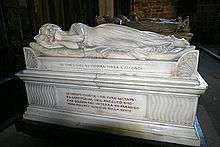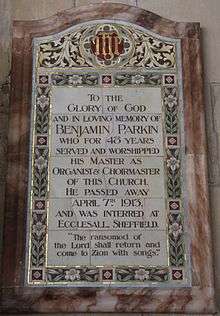St Oswald's Church, Ashbourne
| St. Oswald's Church, Ashbourne | |
|---|---|
 | |
| Coordinates: 53°00′59″N 1°44′10″W / 53.01641°N 1.73612°W | |
| Country | United Kingdom |
| Denomination | Church of England |
| Churchmanship | Broad Church/Central |
| Website | www.ashbournechurch.org |
| History | |
| Dedication | Oswald of Northumbria |
| Dedicated | 24 April 1241 |
| Architecture | |
| Heritage designation | Grade I listed building |
| Designated | 1240 |
| Architectural type | Perpendicular Gothic |
| Specifications | |
| Spire height | 212 feet (65 m) |
| Administration | |
| Parish | Ashbourne |
| Diocese | Diocese of Derby |
| Province | Canterbury |
St Oswald's Church is a Church of England parish church located in Ashbourne, in the county of Derbyshire, England.
Background
The church is named after Oswald of Northumbria.[1] A brass plaque in the chapel on the south side of the church commemorates its dedication on 24 April 1241 by Hugh de Pateshull, Bishop of Coventry and Lichfield.
Architecturally, it dominates the small town with its 212-foot spire which was referred to by George Eliot as the "finest single spire in England". It is said to have been started in 1240[2] by Hugh de Pateshull, Bishop of Coventry. Construction probably lasted until the early 14th century. It replaced an earlier Saxon church, and possibly a second Norman one. (A Norman crypt was discovered during excavations in 1913.)
From 1837 to 1840, it was restored by Lewis Nockalls Cottingham, and then in the 1870s by George Gilbert Scott, who added the battlements to the chancel.[3]
Until Ashbourne Hall was partially demolished, it and St. Oswald's were the town's major monuments, standing at either end of the main street. The entrance to the hall's grounds continued the main street through high gates. What remains of the hall houses the local lending library and some unrelated offices. As they were before the 18th century when the Boothby's rebuilt and refurbished their home, St.Oswald's and its tower are once again the major landmark, and the church is the town's main attraction. The church is a Grade I listed building.[4]
Stained glass
There is much stained glass in the church and these include a Christopher Whall window dated 1905. It was given to the church by Mr and Mrs. Peveril Turnbull of Sandybrook Hall and it commemorates their daughters who died in a local fire. The window consists of three lights and contains representations of the Martyr Saints, St Cecilia, St Monica and St Dorothea. St Cecilia is seen falling asleep to the sounds of celestial music; an exquisite symbol of death. Girls play the organ dressed in medieval clothes with flowers and crowns in their hair and the celestial city is visible in one panel, viewed through a thicket of thorns. Whall’s signature on this stained glass was his own thumbprint.
 East window by Charles Eamer Kempe
East window by Charles Eamer Kempe South transept window by Hardman and Co
South transept window by Hardman and Co West window by Charles Eamer Kempe
West window by Charles Eamer Kempe North transept window showing the Benedictus by Hardman and Co.
North transept window showing the Benedictus by Hardman and Co. Memorial to the Turnbull daughters by Christopher Whall
Memorial to the Turnbull daughters by Christopher Whall Detail of the Christopher Whall window
Detail of the Christopher Whall window
Memorials
Each of its transepts houses a chapel dedicated to leading local families. In the north transept, the Cockaynes, and the Boothbys (who bought their home Ashbourne Hall in the early 18th century). In the south transept is the Bradbourne's chapel. These chapels contain funerary monuments which have contributed greatly to the church's renown.
One in particular stands out: the Boothby monument to Penelope Boothby, daughter of Sir Brooke Boothby (6th Baronet). It is an exquisite and highly realistic sculpture made from Carrara marble (Italian) in the form of a sleeping child.[1] It is considered to be the masterpiece of the artist Thomas Banks, and was commissioned by Penelope's father. There is an inscription on the tomb from Dante, one in French, one in Latin. That in English reads "She was in form and intellect most exquisite. The unfortunate Parents ventured their all on this frail Bark. And the wreck was total."
Other monuments and inscriptions in the church recall the generations of Boothbys buried there.The 6th baronet Boothby was a minor poet, now known mainly for the sonnets which he wrote after his daughter's death – "Sorrows Sacred to the Memory of Penelope", which was illustrated with engravings of pictures by Fuseli and Glover. During his life he published several times on the church's inscriptions. It was said that he never recovered from the loss of his daughter, and he died in poverty in Boulogne-sur-Mer in 1824.
The churchyard contains war graves of two soldiers of World War I and an army officer of World War II.[5]
 The Boothby Monument
The Boothby Monument Another view of the tomb of Penelope Boothby
Another view of the tomb of Penelope Boothby Memorial to John and Anne Bradbourne
Memorial to John and Anne Bradbourne
Vicars of Ashbourne
- Geoffrey
- Nicholas de Esseburne 1200
- William 1231–1233
- Walter de Keyiam 1241
- John de Brecham
- Peter de WIntonia 1260
- Nicholas 1275
- Hugh de Ashburne 1278
- Robertus 1290
- Thomas de Welleton 1300
- Robert de Stoke 1310
- Robert Ible 1310
- John de Lenton 1333
- Roger de la Dale 1349
- William Rymour de Newenham 1361
- William de Exton 1362
- John de Hylle 1363
- William Newenham 1364
- William Prate (or Poyner)
- Hugh de Montgomery 1371
- Ruchard de Thrumley 1373
- Thomas Brouster (or Brondeston) 1379
- Thomas de Hulton 1380
- William Borgh 1394
- William Melton 1394
- Roger de Knyveton 1408
- William Dalton 1408
- William Newerk 1410
- John Sutton
- Thomas Derby 1433
- Richard Forde
- Adam Wetton 1439
- John Clarke 1453
- John Northampton 1470
- Stephen Surtas 1497
- Henry Hudson 1500
- William Tykhill
- Robert Sacheverel 1526
- Laurence Horobyn 1535
- Christopher Hauke or Hawke
- William Bythinge 1564
- Robert Hurte 1566
- Thomas Peacock 1603
- William Wayne 1643
- Samuel Moore 1653
- Thomas Brown 1660
- Thomas Goodread 1669
- John Manson 1702
- Nathaniel Boothouse 1705
- Abraham Jeacocke 1717
- John Boydell 1719
- Luke Hutchinson 1731
- John Fitzherbert 1749
- William Webb 1772
- Samuel Shipley 1806
- John Richard Errington 1850
- Edward Marsham Moore 1872
- Alfred Olivier 1876
- Francis Jourdain 1878
- Ernest Edwin Morris 1898
- Francis Longsdon Shaw 1924
- Philip Charles Thurlow Crick 1935
- Alfred Ellis Farrow 1937
- Claude Charles W Trendell 1949
- Frederick John Henry Lisemore 1957
- William Gerald Armstrong
- David Henry Sansum 1976
- Michael Smith 1998
Organ
A new organ by Valentine of Leicester was installed in 1710. An organ was obtained in 1826 by the builder Parsons.[6] It was enlarged in 1840. The current organ dates from 1858 and may contain pipework from an eighteenth-century instrument. It has had several restorations, including by Hill and Son in 1858, Hill again in 1876, Hill, Norman and Beard in 1950–51, 1982 and 2011 by Henry Groves & Son. A specification of the organ can be found on the National Pipe Organ Register.[7]
Organists

- Mr Binnell (c. 1746)[8]
- Edward Simms (c. 1797–1832)[9]
- George Frederick Simms (1832–34)[10]
- Andrew Loder (1834–38)[11]
- Mr R.W.H. Burrage (1840[12]–44;[13] formerly assistant organist at Norwich Cathedral)
- Mr Loder (Andrew again?) ??–1846–1853–??
- Benjamin Parkin (1856–1904)[14]
- G.F.H. Kemp (c. 1936)[15]
- Chris Daly Atkinson 1944–92
- Michael Halls
See also
References
- 1 2 "Ashbourne church". derbyshireil.net.
- ↑ A new and comprehensive gazetteer of England and Wales. James Bell. 1836
- ↑ "Ashbourne Derbyshire – St Oswald's Parish Church". ashbourne-town.com. Retrieved 10 December 2010.
- ↑ Historic England. "Parish Church of St Oswald (Grade I) (1207715)". National Heritage List for England. Retrieved 17 June 2016.
- ↑ "Ashbourne (St. Oswald) Churchyard". Commonwealth War Graves Commission. Retrieved 17 June 2016. Breakdown obtained from casualty record.
- ↑ Organa britannica: organs in Great Britain 1660–1860. James Boeringer
- ↑ "Derbyshire Ashbourne, St. Oswald, Church Street [N00403]". National Pipe Organ Register. Retrieved 17 June 2016.
- ↑ Derby Mercury – Friday 1 August 1746
- ↑ Staffordshire Advertiser – Saturday 4 February 1832
- ↑ Leamington Spa Courier – Saturday 20 September 1834
- ↑ Derby Mercury – Wednesday 28 March 1838
- ↑ Staffordshire Gazette and County Standard – Saturday 27 June 1840
- ↑ Norfolk Chronicle – Saturday 7 December 1844
- ↑ Sheffield Daily Telegraph – Friday 29 January 1904
- ↑ Derby Daily Telegraph – Monday 14 September 1936
External links
![]() Media related to St Oswald's Church, Ashbourne at Wikimedia Commons
Media related to St Oswald's Church, Ashbourne at Wikimedia Commons
- Information about the church, from derbyshire.uk, a guide to Derbyshire and the Peak District National Park.